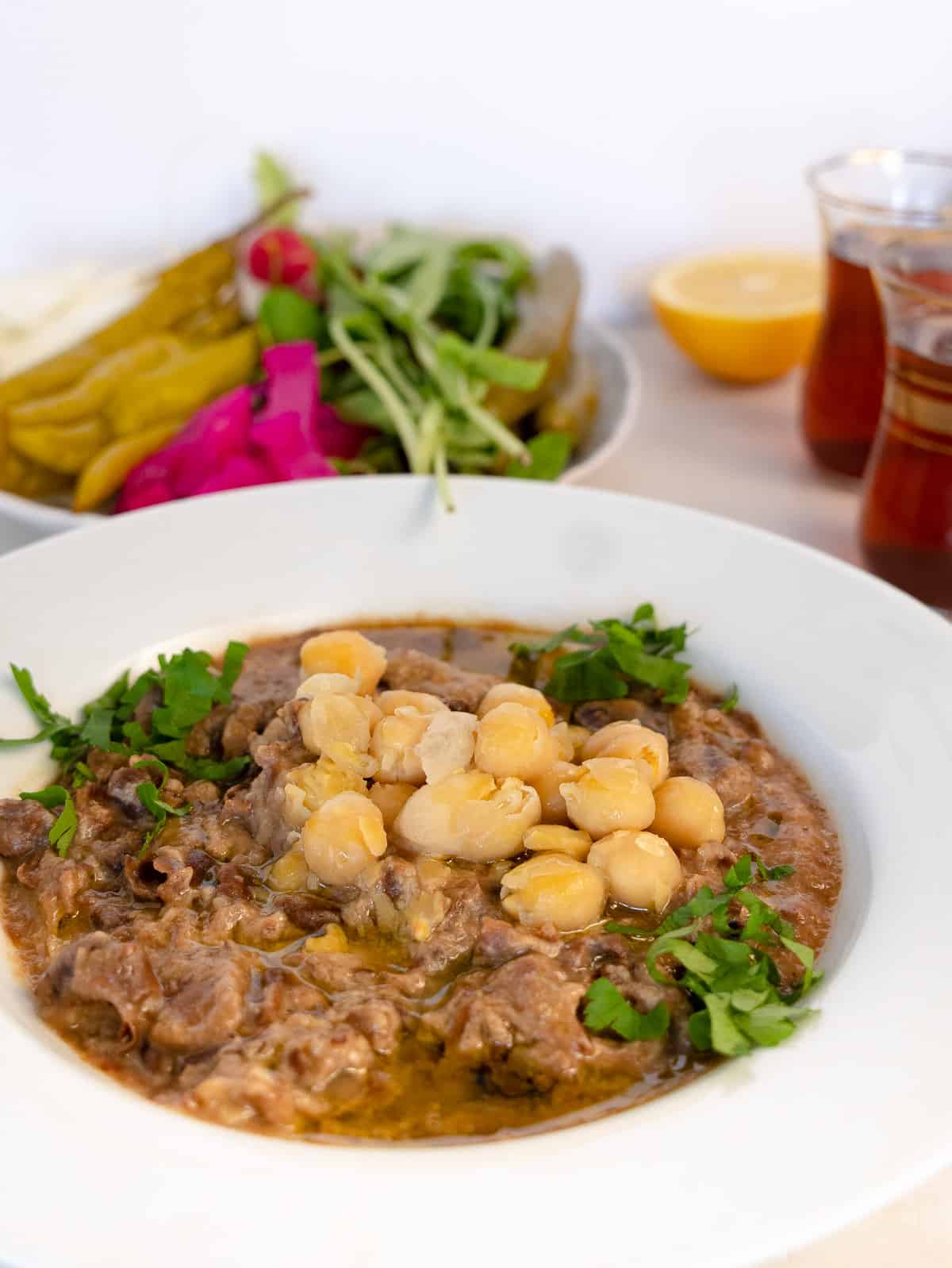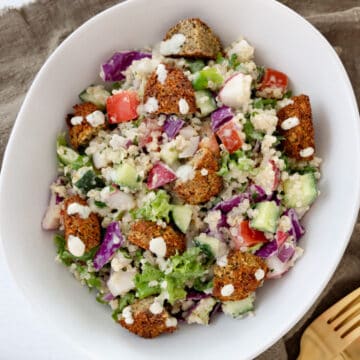Lebanese fava beans are a typical breakfast comfort food called foul moudamas. Tender cooked faba beans that have been hand mashed with lemon and garlic then topped with olive oil.

What is Foul Moudamas?
Foul moudamas is a warm stew of dried fava beans (broad beans or faba beans) that have been slow-cooked, typically for 10-12 hours.
The foul are mixed through a base sauce of garlic, salt, and lemon. Then drizzled with a generous amount of olive oil.
Foul moudamas is found throughout the Middle East as an omnipresent staple, where there are many variations.
In Lebanon, there are specialty shops dedicated to foul.
Foul Moudamas in English
Foul moudamas in English is pronounced as fool moo·dum·mas in Arabic.
It is also known as ful, foul, foul mdamas, and ful medamas. This pronunciation is dependent on the region in the Middle East.
The word “foul” is fava beans.
😋Why You’ll Love This Recipe
- A tempting, warming and filling meal for breakfast - foul is known to satiate
- Easy to make and inexpensive
- Faba beans offer an impressive amount of nutrition
- Can be topped with various ingredients - see variations.
- Is always paired with some form of chickpea dishes such as baleela
✔️Ingredients You’ll Need

The complete list of ingredients with measurements, can be found in the full recipe card below.
Fava beans - to save on time, use the canned variety, which you can heat up in a pot. Otherwise, if you don’t mind cooking it from the dry variety (my preference, albeit longer prep time. The taste is way better) see how to cook the dry variety.
Chickpeas - are popular with foul moudamas and are usually used as a topper or mixed through. This is up to you.
Fresh lemon juice adds a nice sourness to the chickpeas.
Tahini whilst optional bolsters the creaminess of the foul and gives a nutty taste.
Olive oil - use a high-quality extra virgin olive to top the foul moudamas. Normally a liberal amount is used, I have however limited to one tablespoon in this recipe - personal preference.
If you are avoiding oils in your diet, just leave it out.
Crushed garlic clove the size is up to you.
Salt - to taste.
🔪How to Make Foul Moudamas
Step 1 - In a pot over med-high heat, heat up faba beans with their brine until completely warm. Optionally, warm up a ¼ cup of whole chickpeas separately over medium-high heat in a pot. Set aside.
Step 2 - In a bowl, combine salt, lemon juice, and garlic. Mash through the warmed ful with brine), now mash through tahini and combine everything together as evenly as possible.
The texture should be a combination of chunky and mash.
Top with olive oil and optional warmed whole chickpeas. Serve warm (ful is typically served in the famous Lebanese brown bowls.
See serving and garnish suggestions.
How to Cook Dry Fava Beans
Soak sorted beans in water for about 8 hours (1 cup fava to 5 cups water), they should be fully reconstituted.
Then pour the beans and water into a pot, bring to a boil on high heat, then slow cook on low-medium heat for 10-12 hours.
You may need to top up the water with warm water. The ful should be falling apart.
Note - As the skin of ful is tough, they are cooked for a prolonged period of time, although the flesh itself is soft after 1-2 hours of cooking.

🥗Serving Suggestion
As mentioned earlier, chickpea dishes such as musabaha are always paired with foul. Although, in my household we tend to make either or.
Use Lebanese bread (pita bread) is used to scoop the foul moudamas and enjoyed with a plate of fresh and pickled vegetables (fresh mint, tomato, radish, pickled turnip known as lifit, olives, pickled green chili, and pickled Armenian cucumbers (snake cucumbers).
A cup of cinnamon black tea or mint tea is enjoyed too.
🌿Garnish Suggestions
Some of the traditional garnishes include;
Chopped parsley and mint leaves
Whole tender chickpeas
Paprika, cumin, chili powder
Diced fresh tomato

🌟Pro Tips
Foul moudamas is only ever made with dry beans and not fresh.
If you have the fresh variety, try this foul akhdar recipe.
The cooked faba beans need to be semi-mashed and chunky, it is generally done using a pestle in the bowl that it will be consumed.
For convenience, I mash mine with a fork.
🥄Variations
Each country and region in the Middle Eastern has its version of ful medamas, below are some variations;
Use vinegar and tahini rather than lemon juice and tahini. This version is great with spices such as hot chili and paprika powders.
Chopped tomato, parsley, onions, and radish can be mixed throughout. This is referred to as foul salad.
A spoonful of plain yogurt is mixed through. You can use tahini, lemon, and garlic with this.
This is a personal preference, but you can also mash through cooked chickpeas into any type of foul.

❓FAQ
Foul medamas tastes very creamy, tangy, garlicky and a tad nutty from the beans. Each bite is bold, addictive and umami. Foul is unique in flavoring and can be topped with various spices which the beans take on really well.
This is the fun part, usually, it is eaten with torn bite-sized pieces of pita bread that are used as a scoop to pick up the foul mudammas. I personally love to also eat it, by scooping it up with pieces of white onion. The flavor combination is addictive. A side of fresh and pickled vegetables is always enjoyed.
Did you make this? I'd love to know! Leave me a comment below with a ★★★★★ star rating or tag @plantbasedfolk on social media.
Recipe

Creamy Foul Moudamas (Lebanese Fava Beans)
Ingredients
- 1 cup Fava beans canned (if using dry beans, see notes)
- ½ teaspoon Salt or to taste
- ½ small Lemon freshly squeezed
- 1 tablespoon Olive oil or to taste
- 1 clove Garlic crushed
- 1 tablespoon Tahini or to taste
- ¼ cup Cooked chickpeas optional
Instructions
- In a pot over med-high heat, heat up fava beans with its brine until completely warm. Optionally, warm up a ¼ cup of whole chickpeas separately over medium - high heat in a pot. Set aside.
- In a bowl, combine salt, lemon juice and garlic. Mash through the warmed fava beans with brine), now mash through tahini and combine everything together as evenly as possibly. The fava beans should be chunky and mash. Top with olive and optional warmed whole chickpeas. Serve warm. See serving and garnish suggestions.
Video
Notes
Nutrition
N.B., nutrition info is an estimate based on an online nutrition calculator. This will vary based on the specific ingredients you use.
If you enjoyed this recipe, consider supporting my work for the cost of a cup of coffee.






Sharone Trager-Hanoch
It came out a bit bitter. Should I have removed the shells before mashing?
Janelle Hama
Peeling fava beans for ful is a personal preference. Skin on or off, both work.
Skin on, there will be more texture. Skin off, and the ful mudummas will be creamier. The canned variety has softer skins. The dry ones are tougher.
See which one you like. Sahtein Sharone!
Gigi
So my beans have been soaking for 24 hours, but the skins are still hard to remove. It seems like in this recipe the skins are supposed to stay on and you actually eat them. Is that correct?
Janelle Hama
I recommend taking the skins off when using dry fava beans.
Sharone Trager-Hanoch
Thank you, (: I will next time!
Sharone Trager-Hanoch
if you do need to remove the skins, it has to be done after cooking, I can tell you that much...
Tyanne
My new favorite recipe for fava beans!
Marysa
I haven't had these beans or this dish before. Sounds very interesting, and I enjoy trying new dishes.
Gloria
With the price of groceries these days, beans are always a great choice. Full of protein and affordable. Filling and delicious. Love it with extra lemon
Lizet
I'm so glad I found your site. I want to make a Lebanese dinner for my family, and I found a bunch of recipes I would like to try.
This one is one of them.
Amy
I never would have thought of beans at breakfast time, but they are a great alternative when I get tired of eggs. This recipe is so good!
Kayla
These foul moudamas were so delicious! Ever since I started following you, you have opened my eyes to a whole new culture of cooking and I have loved every recipe!